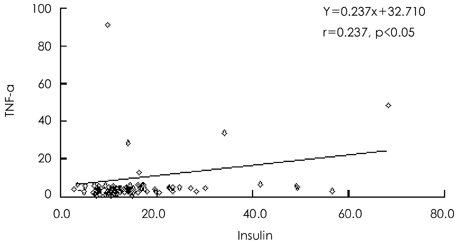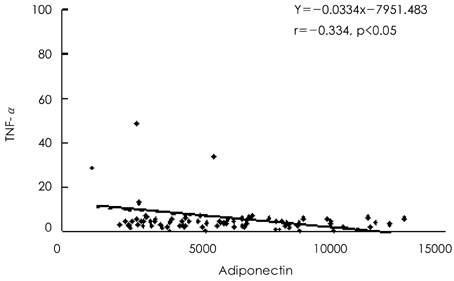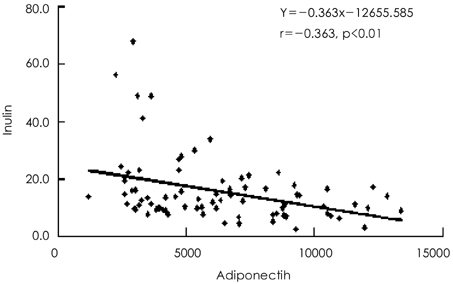Korean Circ J.
2007 Jul;37(7):312-317. 10.4070/kcj.2007.37.7.312.
Serum Cytokine Levels in Hypertensive Children: Tumor Necrosis Factor-alpha, Interleukin-6
- Affiliations
-
- 1Department of Pediatrics, School of Medicine, Ewha Womans University, Seoul, Korea. hongym@chollian.net
- 2Department of Pediatrics, Sejong Hospital, Bucheon, Korea.
- 3Department of Pediatrics, College of Medicine, Ajou University, Suwon, Korea.
- 4Department of Pediatrics, College of Medicine, Hanyang University, Seoul, Korea.
- 5Department of Pediatrics, College of Medicine, Seoul National University, Seoul, Korea.
- KMID: 2227058
- DOI: http://doi.org/10.4070/kcj.2007.37.7.312
Abstract
-
BACKGROUND AND OBJECTIVES: Acute systemic inflammation is associated with an increased risk of acute cardiovascular events. Recently published data have suggested that chronic inflammation could be an independent risk factor for hypertension. Association between interleukin (IL)-6 or tumor necrosis factor (TNF)-alpha and hypertension is controversial. The purpose of this study is to investigate the association between blood pressure and cytokines such as TNF-alpha, IL-6 and adiponectin in hypertensive children.
SUBJECTS AND METHODS
Eighty hypertensive children were included in this study. The obesity index, body mass index (BMI) and skin fold thickness of the subjects were measured, and the fat mass and distributions analyzed. Blood pressure was also measured, as were the serum aldosterone, renin, angiotensin converting enzyme (ACE), insulin and homocysteine levels. The serum TNF-alpha, IL-6 and adiponectin levels were also estimated.
RESULTS
The serum renin, insulin, homocysteine and IL-6 levels were significantly increased in hypertensive compared to normal children. The serum TNF-alpha level had positive correlation with the insulin and negative correlations with adiponectin levels, respectively. The level of insulin had a significant negative correlation with that of adiponectin.
CONCLUSION
The serum IL-6 level was significantly increased in hypertensive children. Further long-term follow-up studies will be required to reveal the role of cytokines in hypertensive children.
Keyword
MeSH Terms
-
Adiponectin
Aldosterone
Blood Pressure
Body Mass Index
Child*
Cytokines
Homocysteine
Humans
Hypertension
Inflammation
Insulin
Interleukin-6*
Interleukins
Obesity
Peptidyl-Dipeptidase A
Renin
Risk Factors
Skin
Tumor Necrosis Factor-alpha*
Adiponectin
Aldosterone
Cytokines
Homocysteine
Insulin
Interleukin-6
Interleukins
Peptidyl-Dipeptidase A
Renin
Tumor Necrosis Factor-alpha
Figure
Reference
-
1. McCarron RM, Wang L, Sirén AL, Spatz M, Hallenbeck JM. Monocyte adhesion to cerebromicrovascular endothelial cells derived from hypertensive and normotensive rats. Am J Physiol. 1994. 267:H2491–H2497.2. Liu Y, Liu T, McCarron RM, et al. Evidence for activation of endothelium and monocytes in hypertensive rats. Am J Physiol. 1996. 270:H2125–H2131.3. Kranzhöfer R, Schmidt J, Pfeiffer CA, Hagl S, Libhy P, Kubler W. Angiotensin induces inflammatory activation of human vascular smooth muscle cells. Arterioscler Thromb Vasc Biol. 1999. 19:1623–1629.4. Schieffer B, Schieffer E, Hilfiker-Kleiner D, et al. Expression of angiotensin II and interleukin 6 in human coronary atherosclerotic plaques: potential implications for inflammation and plaque instability. Circulation. 2000. 101:1372–1378.5. Ross R. Atherosclerosis: an inflammatory disease. N Engl J Med. 1999. 340:115–126.6. Chae CU, Lee RT, Rifai N, Ridker PM. Blood pressure and inflammation in apparently healthy men. Hypertension. 2001. 38:399–403.7. Feely J, Mahamud A. Arterial stiffness is related to systemic inflammation in essential hypertension. Hypertension. 2005. 46:1118–1122.8. Hingorani AD, Cross J, Kharbanda RK, et al. Acute systemic inflammation impairs endothelium-dependent dilatation in humans. Circulation. 2000. 102:994–999.9. Bautista LE, Vera LM, Arenas IA, Gamarra G. Independent association between inflammatory markers (C-reactive protein, interleukin-6, and TNF-α) and essential hypertension. J Hum Hypertens. 2005. 19:149–154.10. Ito H, Ohshima A, Tsuzuki M, et al. Association of serum tumour necrosis factor-alpha with serum low-density lipoprotein-cholesterol and blood pressure in apparently healthy Japanese women. Clin Exp Pharmacol Physiol. 2001. 28:188–192.11. Furumoto T, Saito N, Dong J, Mikami T, Fujii S, Kitabatake A. Association of cardiovascular risk factors and endothelial dysfunction in Japanese hypertensive patients: implications for early atherosclerosis. Hypertens Res. 2002. 25:475–480.12. Mendall MA, Patel P, Asante M, et al. Relation of serum cytokine concentrations to cardiovascular risk factors and coronary heart disease. Heart. 1997. 78:273–277.13. Sheu WH, Lee WJ, Chang RL, Chen YT. Plasma tumor necrosis factor alpha levels and insulin sensitivity in hypertensive subjects. Clin Exp Hypertens. 2000. 22:595–606.14. Ridker PM, Cushman M, Stampfer MJ, Tracy RP, Hennekens CH. Inflammation, aspirin, and the risk of cardiovascular disease in apparently healthy men. N Engl J Med. 1997. 336:973–979.15. Ridker PM, Hennekens CM, Buring JE, Rifai N. C-reactive protein and other markers of inflammation in the prediction of cardiovascular disease in women. N Engl J Med. 2000. 342:836–843.16. Ridker PM, Rifai N, Stamfer MJ, Hennekens CH. Plasma concentration of interleukin-6 and the risk of future myocardial infarction among apparently healthy men. Circulation. 2000. 101:1767–1772.17. Harris TB, Ferrucci L, Tracy RP, et al. Associations of elevated interleukin-6 and C-reactive protein levels with mortality in the elderly. Am J Med. 1999. 106:506–512.18. Volpato S, Guralnik JM, Ferrucci J, et al. Cardiovascular disease, interleukin-6, and risk of mortality in older women: the women's health and aging study. Circulation. 2001. 103:947–953.19. Trayhurn P, Beattie JH. Physiological role of adipose tissue: white adipose tissue as an endocrine and secretory organ. Proc Nutr Soc. 2001. 60:329–339.20. Maeda K, Okubo K, Shimomura I, et al. cDNA cloning and expression of a novel adipose specific collagen-like factor, apM1 (Adipose Most abundant Gene transcript 1). Biochem Biophys Res Commun. 1996. 221:286–289.21. Weyer C, Funahashi T, Tanaka S, et al. Hypoadiponectinemia in obesity and type 2 diabetes: close association with insulin resistance and hyperinsulinemia. J Clin Endocrinol Metab. 2001. 86:1930–1935.22. Yamauchi T, Kamon J, Waki H, et al. Globular adiponectin protected ob/ob mice from diabetes and apoE deficient mice from atherosclerosis. J Biol Chem. 2002. 278:2461–2468.23. Ouchi N, Kihara S, Arita Y, et al. Adipocyte-derived plasma protein, adiponectin, suppress lipid accumulation and class A receptor expression in human monocyte-derived macrophages. Circulation. 2001. 103:1057–1063.24. Yamauchi T, Kamon J, Minokoshi Y, et al. Adiponectin stimulates glucose utilization and fatty-acid oxidation by activating AMP-activated protein kinase. Nat Med. 2002. 8:1288–1295.25. Kondo H, Shimomura I, Matsukawa Y, et al. Association of adiponectin mutation with type 2 diabetes: a candidate gene for the insulin resistance syndrome. Diabetes. 2002. 51:2325–2328.26. Mallamaci F, Zoccali C, Cuzzola F, et al. Adiponectin in essential hypertension. J Nephrol. 2002. 15:507–511.27. Kazumi T, Kawaguchi A, Sakai K, Hirano T, Yoshino G. Young men with high-normal blood pressure have lower serum adiponectin, smaller LDL size, and higher elevated heart rate than those with optimal blood pressure. Diabetes Care. 2002. 25:971–976.28. Hong SJ, Park CG, Park JS, et al. The relationship between serum adiponectin, essential hypertension, LV mass index, and LV diastolic function. Korean Circ J. 2003. 33:1126–1133.29. Hong YM, Lee JY, Jung JW, et al. Normal blood pressure values and percentile curves in children. Korean Circ J. 2006. 36:744–752.30. Shin JU, Cho HK, Shin MS. Elevated tumor necrosis factor-α in stable angina pectoris. Korean Circ J. 2000. 30:861–866.31. Park CG. Hypertension and vascular aging. Korean Circ J. 2006. 36:477–481.32. Adamczak M, Wiecek A, Funahashi T, Chudek J, Kokot F, Matsuzawa Y. Decreased plasma adiponectin concentration in patients with essential hypertension. Am J Hypertens. 2003. 16:72–75.33. Yang WS, Lee WJ, Funahashi T, et al. Plasma adiponectin levels in overweight and obese Asians. Obes Res. 2002. 10:1104–1110.
- Full Text Links
- Actions
-
Cited
- CITED
-
- Close
- Share
- Similar articles
-
- Serum Tumor Necrosis Factor,Interleukin-1β and Interleukin-6 Levels in Behçet's Disease
- Change of cytokine expression in normal pregnancy and the puerperium
- Interleukin-1beta, Tumor Necrosis Factor-alpha, Transforming Growth Factor-beta Expression in Fetal Blood Detected by Reverse Transcriptase-Polymerase Chain Reaction
- The Serum Tumor Necrosis Factor-alpha and Interleukin-1beta in Experimental Acute Pancreatitis of the Rat
- Comparison of Cytokine Expressions among Kawasaki Disease and Its Symptom-related Diseases




